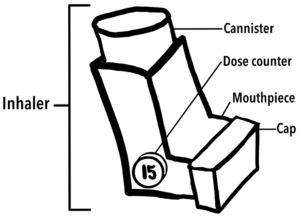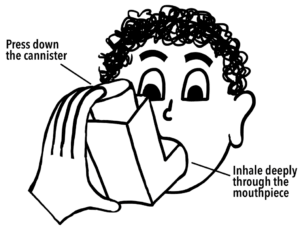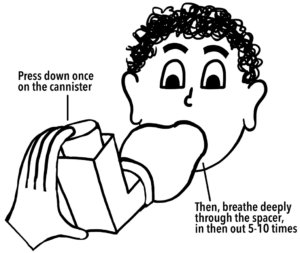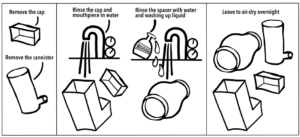What is an inhaler?
By Anoushka

An inhaler is a clever medical device that can fit in the palm of your hand. It contains medications that patients with lung diseases can inhale to help their breathing.
Using an inhaler takes some practice:

First, remove the cap and check the inhaler mouthpiece is clean. Look on the inhaler for its expiry date (hopefully sometime in the future!) and look at the dose counter to check how many doses of medication are left in the canister (hopefully enough!).
Next, hold the inhaler between your thumb and index finger, with your index finger placed on the canister.
Breathe out fully, then put your lips securely over mouthpiece.
Breathe in slowly and deeply through the inhaler while pressing down on the canister with your index finger.
Pressing down on the canister once releases one dose of medication from the canister into the mouthpiece, and subtracts one dose from the reading on the canister.
Once you’ve breathed in fully, hold your breath for 10 seconds. Then, remove the inhaler and breathe out.

Are inhalers hard to use?
As with many skills, practice makes perfect.
Nevertheless, patients often find that the most challenging aspect of inhaler use is coordinating pressing down the canister while breathing in deeply. It’s particularly difficult to concentrate on careful coordination while feeling acutely breathless!
Luckily, biomedical engineers designed a solution – it’s called a spacer.
The spacer fits onto the mouthpiece of the inhaler once the cap has been removed.
Press the canister to deliver one dose of medication into the spacer device. Then, put your lips firmly around the end of the spacer device and breathe deeply in and out five times, keeping your lips around the spacer throughout inhaling and exhaling.

Looking after an inhaler requires some care
Instructions sometimes vary for different types of inhalers. One standard cleaning routine is as follows:
- Each week, remove the cap and canister from the inhaler.
- Rinse the cap and mouthpiece in water, leave these to air-dry overnight, then replace the canister and cap.
- Spacers need cleaning once per month. They should be washed using washing up liquid, rinsed with water, then left out to dry overnight.




